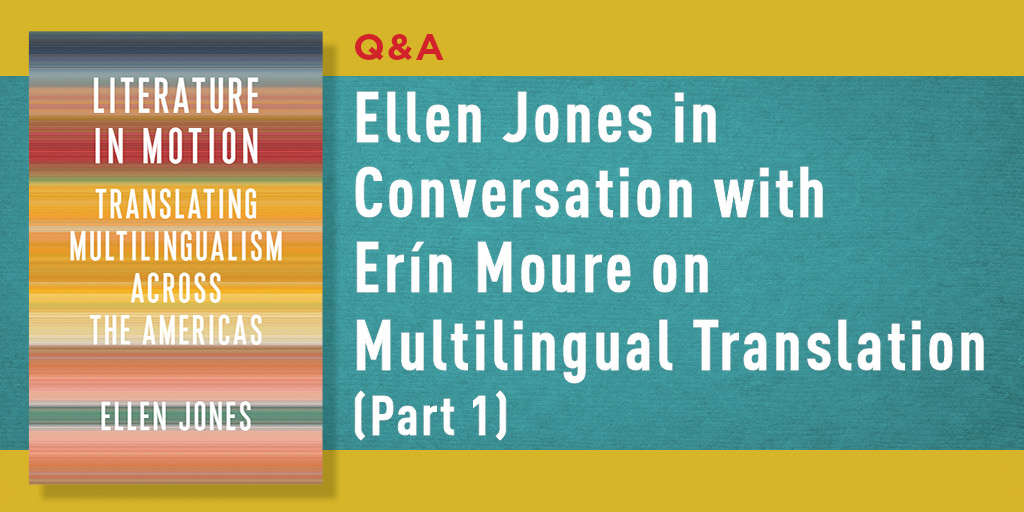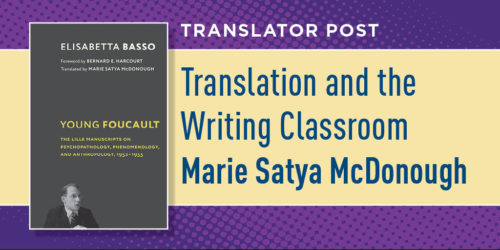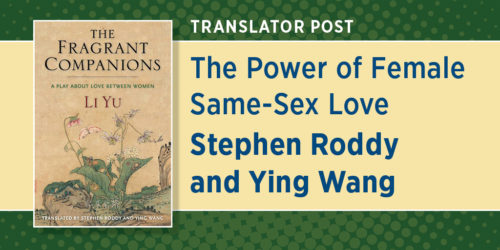Ellen Jones in Conversation with Erín Moure on Multilingual Translation (Part 1)

In Literature in Motion: Translating Multilingualism Across the Americas, I think about how authors and translators can use the defamiliarizing and disruptive potential of literary multilingualism to resist conventions of form and dominant narratives about language and gender. One of the book’s case studies is Erín Moure’s Paraguayan Sea, a multilingual translation of Brazilian writer Wilson Bueno’s Mar Paraguayo (1992). To mark the book’s publication, Erín kindly spoke to me about the book’s use of language, where translation fits into her literary practice, and her numerous other multilingual projects.
Ellen Jones: Paraguayan Sea is a wonderful example of how translation need not erase the difficulty or ingenuity of multilingual writing; it, too, can be linguistically playful and challenging, a creative practice to be valued in the same way as any other writing. It helps us understand translation as productive and original rather than as derivative and secondary. Part of that creativity is expressed in the book’s many linguistic games and tricks. Did you have fun translating Paraguayan Sea?
Erín Moure: I nod at what you say re: creative practice; for me translating poetry is part and parcel of my poetic practice. I find it endlessly engaging to immerse in a book’s machinery, its tactics and reverberations, rhythms and longings, and try to receive those aspects of meaning while expanding my knowledge by doing research into what provokes the book’s lexicons and movements and by listening to the language and its flows, as best I can, in order to bring the book’s complexity into English (or Frenglish . . .).
As well as having fun, I felt a deep responsibility to Wilson Bueno. I met him by mail after I’d translated three pages of the book for the Oxford Book of Latin American Poetry, and he was so enthused. I’d promised him I would one day translate the whole book, and finding the time was not easy, as I needed a big mental space to “hold” this project and keep it in my head while doing the research and finding the rhythms. I couldn’t afford the time away until 2013–2014 when I was writer-in-residence at the University of Alberta in Edmonton, paid to write! In the interim, tragically, Wilson Bueno died. But I was determined to keep my promise.
EJ: On your website you describe yourself as, among other things, “translator from Galician, French, Spanish, Portuñol, and Portuguese to English, Galician and English to French.” Seeing Portuñol on this list makes me wonder: to what extent was it helpful to understand Portuñol as a discrete language? Was there a point during the translation where you stopped trying to pull Spanish and Portuguese apart? Or was that never part of your translational process?
EM: Perhaps because I approach Spanish, Portuguese, and Portuñol via Galician, Portuñol to me is distinctive and very easy to sink into. I just read it as Portuñol, aware that it blends Spanish and Portuguese but with no need to take it apart at all! This could also be due to the influences around me. In Québec, we have joual, a French working-class speech of long existence that, due to the anglo-colonialism that followed French colonial period, absorbed a lot of English. Next door, in the province of New Brunswick, the blended Acadian speech called Chiac developed among native French speakers who were only allowed in their era to go to English school (francophones have more rights regarding schooling in French). Chiac is used by Acadian writers as a language on its own. Something similar happens, I imagine, in other places where administrative colonial borders and settler linguistic borders don’t exactly coincide. In the West of Brazil near Paraguay and Argentina, for example, Brazilians whose mother tongue is Spanish go to school in Portuguese. Under such circumstances, languages do start to blend. Even in Galicia, among Galician speakers, there’s castrapo, a kind of Galician way to speak Castilian Spanish (considered bad Castilian, or uneducated, by many, but I think of it as a possible language—my own Spanish is definitely castrapo as I never formally learned Castilian and access it too via Galician).
EJ: Since my own book, and this blog, are directed at readers of English(es), I’ve been thinking about your translation’s complicated relationship with that language. What are the political implications of bringing Mar Paraguayo into the Anglophone publishing sphere, and especially to the U.S.?
EM: Well, English is nearly always to some degree “impure,” since it is so geographically widespread as a first and second language and lives close to or is intertwined with many other linguistic and cultural spaces. Spanish, or Castilian, is widely spoken in the USA, of course, and can inflect local Englishes, but, in my case, I don’t live that hybridity. I live a deep mix of the languages of my own place, French and English, where French exists in English, and English in French, to differing degrees, and I thought Portuñol could translate beautifully into the cacophony of this place and of this translator. I reversed franglais (French contaminated by English, readable to francophones) to create a “Frenglish,” an admixture readable to anglophones. With U.S. readers in mind, I tried to tap lots of French words that are readable by an anglo reader without translation.
I kept the Guaraní. As Bueno says, it is vital to the text—I’d translated a small section years before into Frenglish with Kanienʼkéha, the main Indigenous language of Tiohtià:ke (Montreal), but I soon agreed that the Guaraní is tied to the history and geography of the novel and had to be present
Portuguese- and Spanish-speaking readers can read Mar Paraguayo fairly fluidly; it’s just queered a bit for them by the anarchic mix of spellings and vocables. I wanted the anglo-American reader to receive a queered text as well. To me, English and French seem like very similar languages, as are Spanish and Portuguese, so I think it worked.
EJ: Relatedly, can we think of Paraguayan Sea as an American work, in the hemispheric sense of the word?
EM: Very definitely. The colonialism of Euro-settlement—which damaged and tried to eradicate Indigenous cultures, leaving people in a broken or strange relationship with their mother tongue or historical language—still imbues the governmental and social structures of both North and South Americas. Mar Paraguayo was published in Argentina and in Mexico without translation. I just strongly felt, with Bueno, that it should exist in the USA and Canada too, and that meant calling it into English somehow.
Ellen Jones is a literary translator and an editor. Her translations from Spanish include Ave Barrera’s The Forgery (co-translated with Robin Myers, 2022), Bruno Lloret’s Nancy (2020), and Rodrigo Fuentes’s Trout, Belly Up (2019). She is the author of Literature in Motion: Translating Multilingualism Across the Americas, which will be available in January 2022.
Erín Moure’s most recent poetry collection is The Elements (House of Anansi Press, 2019), “a book of Dad.” The Face of the Quartzes, from Veliz Books (2021), is her sixth translation from the work of Galician poet Chus Pato. A forty-year retrospective, Planetary Noise: Selected Poetry of Erín Moure, appeared in 2017 from Wesleyan University. More info at erinmoure.mystrikingly.com.








